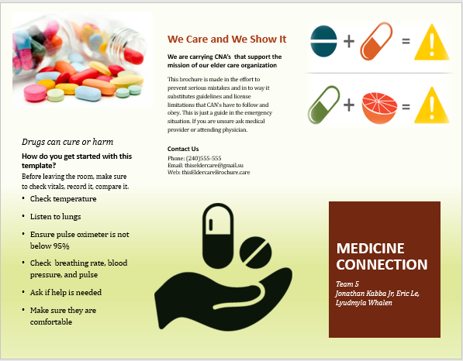
Team: Jonathan Kabba Jr.(Me), Eric Le, and Lyudmila Whalen
Introduction:
Nowadays more and more people take different/multiple kinds of medications (sometimes at once) , going to different doctors/physicians, different pharmacies, no track of what prescribed who and how it all works.
The Brainstorming Phase:
The brainstorming process was done over virtually on Zoom. We utilized a mind map maker to organize our thoughts.
Target Audience:
1) Seniors Living in communities or alone
2) Average population residing home using different unrelated doctors/systems plus self-medicating or over the counter
3) Parents carrying for children that use medication CAN/nurses carrying for broad population of residents using multiple and sometimes rapidly changing meds a day/at a time.
Interview/brainstorm/collaborative project was achieved through various methods:
1) In person
2) For our personal experiences
3) Emails/Chats
4) Phone conferences
5) Mind Map
6) Google Doc
Idea Generation Phase:
After collaboration, we came to the conclusion that people of all ages whether carrying for medication themselves or others around them, as one of the strongest options would call nursing hotline to seek help with taking medication.
The reason why we chose senior population because they are the most vulnerable, reactions rate happen fast, and most of them have multiple medications to take so there is a great significance to the CAN and nurses to have a solid knowledge and a reference material to consult quickly when performing care about the elderly.
Mind Map Maker:

Rapid Prototype Process Phase:

Statement: "Nurses (in senior living/hospitals) should have a resource (such as brochure, website) of non-comprehensive list of medication contradiction to safely perform care about elderly patient population with need of administering/taking multiple medications for multiple chronic conditions."
We worked through two iterations of prototypes before selection the option
we thought would be best convey the concept to test elderly individuals/participants.
1) Brochure
Front Side:

Back Side:

2) Website
The website is consist of the home page, medicine page, services and about page.
Website URL:




Participant Feedback Phase:
1) Diverse range of elderly participants and life background on medication
2) 6 total participants ranging from 60 – 80 years old
3) Post Questionnaire Questions
4) Comments:
1) “This is a fantastic concept to grasp material"
2) “This would save me a long time to understand my medication”
3)“This would help many a lot of elderly people who are trying to read their medication”
5) Results:
1) Positive, negative, neutral feedbacks
2) Recommendations and opinions
SWOT Analysis:

Final Design:
Testing of mockups focused on the website
Additions: Top disorders in the United States on the Medicine Page









Final Thoughts:
1) Good:
-Productive team
-Pretty good understanding of using Mind Map
-Interesting conceptual design
2) Bad:
-Needed to do more iterations and improve testing to more participants
-Product complexity
-Not able to test elderly participants due to COVID-19
3) Ugly:
-Creating a better brochure (need to fix the font on brochure)
-Scaling up on the website
